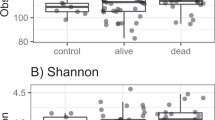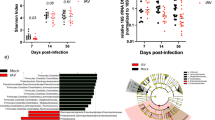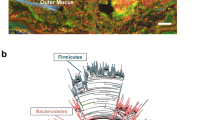Abstract
Maternal transmission and cage effects are powerful confounding factors in microbiome studies. To assess the consequences of cage microenvironment on the mouse gut microbiome, two groups of germ-free (GF) wild-type (WT) mice, one gavaged with a microbiota harvested from adult WT mice and another allowed to acquire the microbiome from the cage microenvironment, were monitored using Illumina 16S rRNA sequencing over a period of 8 weeks. Our results revealed that cage effects in WT mice moved from GF to specific pathogen free (SPF) conditions take several weeks to develop and are not eliminated by the initial gavage treatment. Initial gavage influenced, but did not eliminate a successional pattern in which Proteobacteria became less abundant over time. An analysis in which 16S rRNA sequences are mapped to the closest sequenced whole genome suggests that the functional potential of microbial genomes changes significantly over time shifting from an emphasis on pathogenesis and motility early in community assembly to metabolic processes at later time points. Functionally, mice allowed to naturally acquire a microbial community from their cage, but not mice gavaged with a common biome, exhibit a cage effect in Dextran Sulfate Sodium-induced inflammation. Our results argue that while there are long-term effects of the founding community, these effects are mitigated by cage microenvironment and successional community assembly over time, which must both be explicitly considered in the interpretation of microbiome mouse experiments.
Similar content being viewed by others
Log in or create a free account to read this content
Gain free access to this article, as well as selected content from this journal and more on nature.com
or
References
Arthur JC, Perez-Chanona E, Muhlbauer M, Tomkovich S, Uronis JM, Fan TJ et al (2012). Intestinal inflammation targets cancer-inducing activity of the microbiota. Science 338: 120–123.
Arumugam M, Raes J, Pelletier E, Le Paslier D, Yamada T, Mende DR et al (2011). Enterotypes of the human gut microbiome. Nature 473: 174–180.
Brown CT, Davis-Richardson AG, Giongo A, Gano KA, Crabb DB, Mukherjee N et al (2011). Gut microbiome metagenomics analysis suggests a functional model for the development of autoimmunity for type 1 diabetes. PloS one 6: e25792.
Caporaso JG, Kuczynski J, Stombaugh J, Bittinger K, Bushman FD, Costello EK et al (2010). QIIME allows analysis of high-throughput community sequencing data. Nat methods 7: 335–336.
Claesson MJ, Jeffery IB, Conde S, Power SE, O'Connor EM, Cusack S et al (2012). Gut microbiota composition correlates with diet and health in the elderly. Nature 488: 178–184.
Edgar RC, Haas BJ, Clemente JC, Quince C, Knight R . (2011). UCHIME improves sensitivity and speed of chimera detection. Bioinformatics 27: 2194–2200.
Elinav E, Strowig T, Kau AL, Henao-Mejia J, Thaiss CA, Booth CJ et al (2011). NLRP6 inflammasome regulates colonic microbial ecology and risk for colitis. Cell 145: 745–757.
Garrett WS, Lord GM, Punit S, Lugo-Villarino G, Mazmanian SK, Ito S et al (2007). Communicable ulcerative colitis induced by T-bet deficiency in the innate immune system. Cell 131: 33–45.
Gillilland MG 3rd, Erb-Downward JR, Bassis CM, Shen MC, Toews GB, Young VB et al (2012). Ecological succession of bacterial communities during conventionalization of germ-free mice. Appl Environ Microbiol 78: 2359–2366.
Goldsmith JR, Uronis JM, Jobin C . (2011). Mu opioid signaling protects against acute murine intestinal injury in a manner involving Stat3 signaling. Am J Pathol 179: 673–683.
Hildebrand F, Nguyen AT, Brinkman B, Yunta RG, Cauwe B, Vandenabeele P et al (2013). Inflammation-associated enterotypes, host genotype, cage and inter-individual effects drive gut microbiota variation in common laboratory mice. Genome Biol 14: R4.
Huse SM, Ye Y, Zhou Y, Fodor AA . (2012). A core human microbiome as viewed through 16S rRNA sequence clusters. PloS one 7: e34242.
Jeffery IB, Claesson MJ, O'Toole PW, Shanahan F . (2012). Categorization of the gut microbiota: enterotypes or gradients? Nat Rev Microbiol 10: 591–592.
Ley RE, Backhed F, Turnbaugh P, Lozupone CA, Knight RD, Gordon JI . (2005). Obesity alters gut microbial ecology. Proc Natl Acad Sci USA 102: 11070–11075.
Listgarten J, Lippert C, Kadie CM, Davidson RI, Eskin E, Heckerman D . (2012). Improved linear mixed models for genome-wide association studies. Nat Methods 9: 525–526.
Ma BW, Bokulich NA, Castillo PA, Kananurak A, Underwood MA, Mills DA et al (2012). Routine habitat change: a source of unrecognized transient alteration of intestinal microbiota in laboratory mice. PloS one 7: e47416.
Mazmanian SK, Round JL, Kasper DL . (2008). A microbial symbiosis factor prevents intestinal inflammatory disease. Nature 453: 620–625.
Raudenbush SW, Bryk AS . (2002) Hierarchical linear models : applications and data analysis methods 2nd edn. Sage Publications: Thousand Oaks, xxiv, p 485.
Ross EM, Moate PJ, Bath CR, Davidson SE, Sawbridge TI, Guthridge KM et al (2012). High throughput whole rumen metagenome profiling using untargeted massively parallel sequencing. BMC Genet 13: 53.
Santos Rocha C, Lakhdari O, Blottiere HM, Blugeon S, Sokol H, Bermudez-Humaran LG et al (2012). Anti-inflammatory properties of dairy lactobacilli. Inflamm Bowel Dis 18: 657–666.
Schloss PD, Westcott SL, Ryabin T, Hall JR, Hartmann M, Hollister EB et al (2009). Introducing mothur: open-source, platform-independent, community-supported software for describing and comparing microbial communities. Appl Environ Microbiol 75: 7537–7541.
Segata N, Waldron L, Ballarini A, Narasimhan V, Jousson O, Huttenhower C . (2012). Metagenomic microbial community profiling using unique clade-specific marker genes. Nat Methods 9: 811–814.
Servin AL . (2004). Antagonistic activities of lactobacilli and bifidobacteria against microbial pathogens. FEMS Microbiol Rev 28: 405–440.
Smyth GK . (2004). Linear models and empirical bayes methods for assessing differential expression in microarray experiments. Stat Appl Genet Mol Biol 3: Article3.
Turnbaugh PJ, Ley RE, Hamady M, Fraser-Liggett CM, Knight R, Gordon JI . (2007). The human microbiome project. Nature 449: 804–810.
Turnbaugh PJ, Ley RE, Mahowald MA, Magrini V, Mardis ER, Gordon JI . (2006). An obesity-associated gut microbiome with increased capacity for energy harvest. Nature 444: 1027–1031.
Ubeda C, Lipuma L, Gobourne A, Viale A, Leiner I, Equinda M et al (2012). Familial transmission rather than defective innate immunity shapes the distinct intestinal microbiota of TLR-deficient mice. J Exp Med 209: 1445–1456.
Ursell LK, Clemente JC, Rideout JR, Gevers D, Caporaso JG, Knight R . (2012). The interpersonal and intrapersonal diversity of human-associated microbiota in key body sites. J Allergy Clin Immunol 129: 1204–1208.
Vilhjalmsson BJ, Nordborg M . (2013). The nature of confounding in genome-wide association studies. Nat Rev Genet 14: 1–2.
von Schillde MA, Hormannsperger G, Weiher M, Alpert CA, Hahne H, Bauerl C et al (2012). Lactocepin secreted by Lactobacillus exerts anti-inflammatory effects by selectively degrading proinflammatory chemokines. Cell Host Microbe 11: 387–396.
Wang Q, Garrity GM, Tiedje JM, Cole JR . (2007). Naive Bayesian classifier for rapid assignment of rRNA sequences into the new bacterial taxonomy. Appl Environ Microbiol 73: 5261–5267.
Acknowledgements
We thank the National Gnotobiotic Rodent Resource Center at University of North Carolina for assistance with germ-free mice (NIH P40 R018603). Histology was performed at the CGIBD histology core (P30 DK034987). This work was supported by funding from R01 DK73338 (CJ), R01 DK47700 (CJ), UNC University Cancer Research Fund (CJ) and a Crohn’s and Colitis Foundation of America fellowship to M Mühlbauer.
Author information
Authors and Affiliations
Corresponding authors
Ethics declarations
Competing interests
Anthony Fodor has consulted for the Salix corporation.
Additional information
Supplementary Information accompanies this paper on The ISME Journal website
Supplementary information
Rights and permissions
About this article
Cite this article
McCafferty, J., Mühlbauer, M., Gharaibeh, R. et al. Stochastic changes over time and not founder effects drive cage effects in microbial community assembly in a mouse model. ISME J 7, 2116–2125 (2013). https://doi.org/10.1038/ismej.2013.106
Received:
Revised:
Accepted:
Published:
Issue date:
DOI: https://doi.org/10.1038/ismej.2013.106
Keywords
This article is cited by
-
A consortia of clinical E. coli strains with distinct in vitro adherent/invasive properties establish their own co-colonization niche and shape the intestinal microbiota in inflammation-susceptible mice
Microbiome (2023)
-
Impact of diet and host genetics on the murine intestinal mycobiome
Nature Communications (2023)
-
Identification of gut microbial species linked with disease variability in a widely used mouse model of colitis
Nature Microbiology (2022)
-
The yellow perch (Perca flavescens) microbiome revealed resistance to colonisation mostly associated with neutralism driven by rare taxa under cadmium disturbance
Animal Microbiome (2021)
-
Cage and maternal effects on the bacterial communities of the murine gut
Scientific Reports (2021)



